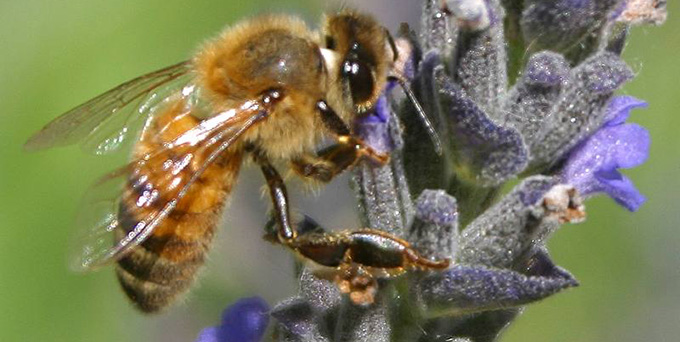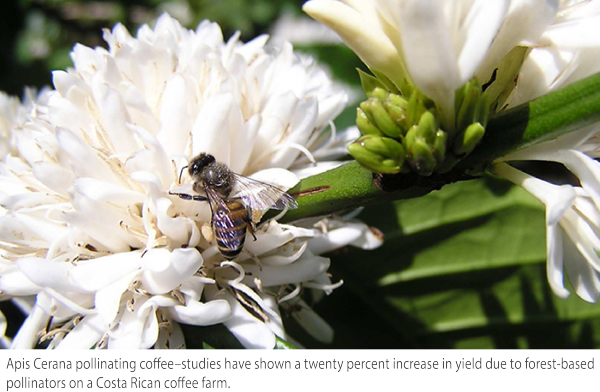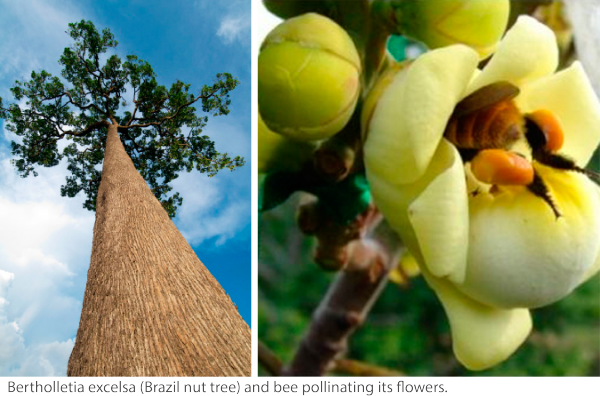There’s been a lot of buzz on bees lately, namely their disappearance. I’ve heard it thrown into conversations as an almost humorous, apologetic footnote to litanies of woeful world situations: “and not to mention whatever’s happening with the bees.” Bees starting showing up in small talk when they started disappearing, and are now more firmly in the public eye as studies on pesticides and their effect on bees have made appearances in the news. But, this is not the whole story by a long shot.
Our connection with bees begins with the first known instances of beekeeping and honey hunting, over 4,500 years ago. Honey appears in sacred texts across various faiths, and its collection and processing have long formed part of many cultures–in Africa honey hunting has even steered the evolution of “honey guides,” wild birds who lead humans to beehives in order to eat the unprotected larvae once the nest has been cleared of bees and the honey has been harvested. And our relationship with our apis amigos is still in its honeymoon, if you will. Bees provides a nice example of the free services nature provides us, and how in turn beekeeping and honey can help farmers in the tropics see the profit in committing to conserving forests.
In ecosystems
The first step in our human-bee alliance is to recognize our utter dependence on them, now as in the past. In fact, it’s not only we who depend on them, but entire ecosystems. It is estimated that 80% of flowering plants depend on insect pollination to reproduce, and that about half of tropical plants–and one third of plants or plant products eaten by humans–depend on pollination specifically by bees. Bees make the perfect pollinators due to their specialized physiology. They are built to capture pollen while collecting nectar for their food stores, and only collect from the same species at any given time, ensuring an efficient pollination process. However, their high level of specialization also poses a danger for the ecosystems that they propagate. Bees must always have some food source, and must be in sufficient numbers when plants are flowering, sometimes a window of just a few days.
On farms
Pollination services–for crops as well as indigenous biodiversity–are far and away the most significant–and valuable–contribution by bees. There are no estimates of bees’ contribution to biodiversity in indigenous plants, but we do have data on their contribution to our crops (and to their profits). For example, Costa Rican coffee farms had twenty percent increases in yields where forest-based pollinators were present, supporting previous studies demonstrating that investing in maintaining wild bee habitat within agricultural landscapes really does pay off, with bees boosting pollination and yields by up to 50%.
Besides coffee, the importance of bees in filling our shopping baskets is also well documented in another “once a day” product: the apple. Beyond product quantity, bees also manage product quality in orchards. Apple weight, as is the case with many fruits, is dependent on sufficient pollination, and its development in the first place already depends on pollination by several bees. Where some seeds have not been pollinated in an apple, fruit mass does not form, and you get punier, misshapen apples. Single strawberries (at least the more traditional variety) can have 400-500 seeds on their surface, requiring at least 21 visits by bees in order for the strawberry to develop fully. Again, the more bees and the more pollinated and fully formed seeds, the larger, and better shaped the berry. Bees also collect pollen from certain species at certain times, meaning your crops are formed and ready at the same time, making for a uniform harvest.
In short, healthy natural habitat = more bees = better yields. (For a great summary of the value of ecosystem services and what happens when farms lose their bees, listen to this podcast by radiolab).
In Forests
Bees are the fuzzy embodiment of “production-protection.” As the Food and Agriculture Organization of the UN put it in their report Bees and their role in forest livelihoods:
“The multipurpose value of trees and forests is increasingly well appreciated, and beekeeping provides one of the most benign ways of obtaining a harvest from natural forests. Apiculture’s unique feature as an activity is the fact that its continuation, through pollination, fosters the maintenance of an entire ecosystem, and not just a single crop or species.”
A beautiful example is the Brazil nut, originating from the Bertholletia excelsa tree, which we’ve written about before in our profile of Shiwi. These Amazonian giants can live for over a thousand years, reach a height of around 60 meters, and provide a crucial source of food and income for native communities. Bertholletia excelsa is pollinated by the Euglossa bee, specifically by the females. These female bees are attracted to the collective aroma of the male Euglossas, who collect the scented material from an orchid that only exists in the Amazon. These males are the only pollinators of this orchid just as the females are the sole pollinators for the Brazil nut trees, thus the trees and the orchids are only found in each other’s presence. This network means that Brazil nuts cannot fit into a plantation system, making their production a model for non-timber forest products.
It has been found that these bees do not cross open areas, so deforestation, fires, and clearing for agricultural use result in the loss of Brazil nut production. This example shows the complexity, specificity, and beauty of the relationships that bees create and maintain in ecosystems, and how these networks can benefit the human participants within them, motivating such producers to take a stand for conservation. Even beekeepers who do not depend upon crop pollination often become involved in protecting their forests, having seen through experience how maintaining the entire system is essential to one species’ survival, and vice versa.
In our next blog post we’ll be taking a deeper look at producers for whom honey is the link between livelihoods and forest conservation.
Recommended Links
[clear]








One thought on “Finally, a hopeful look at bees and conservation”